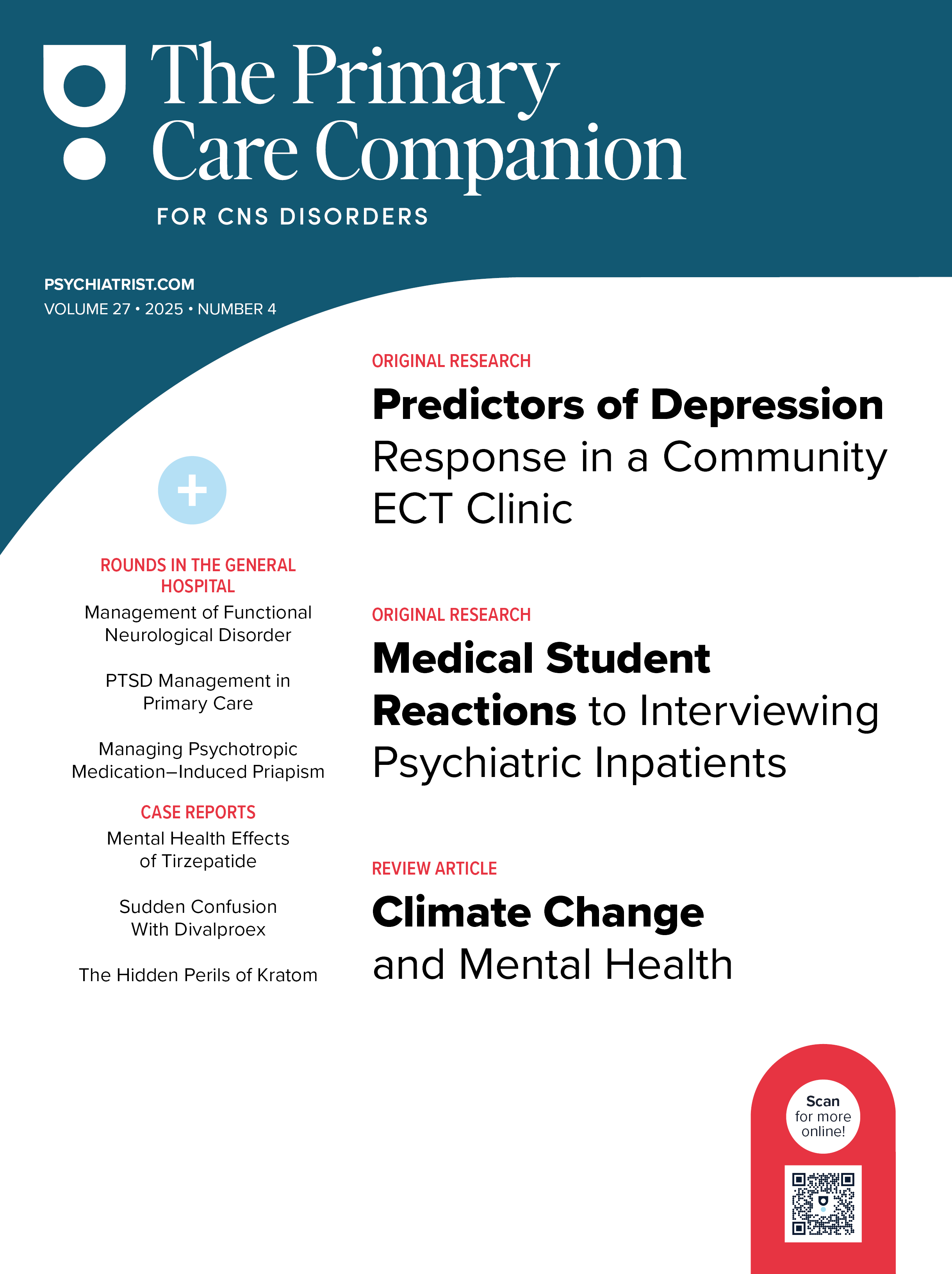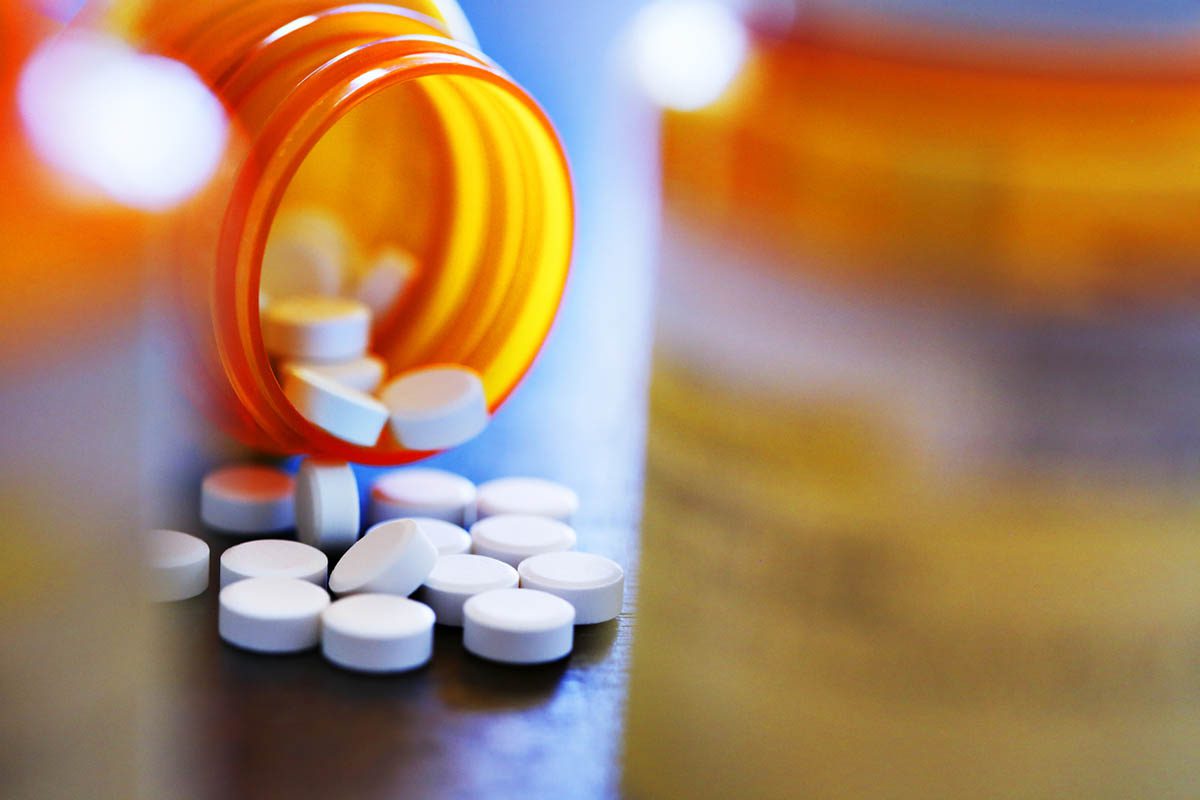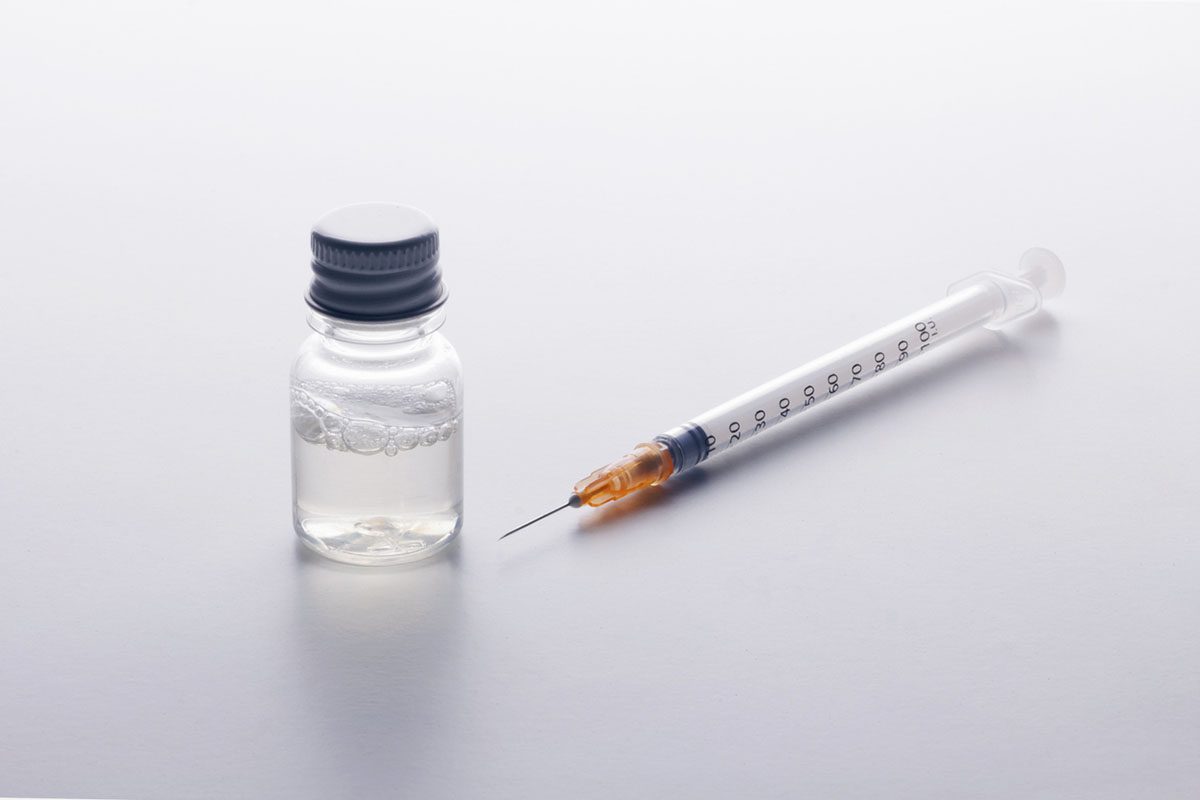“Bath Salts”-Induced Psychosis in a Young Woman
To the Editor: Bath salts is a term used to describe a group of designer drugs that are sold in powder form and marketed under such labels as “pond water cleaner,” “plant food,” or “research chemicals.”1,2 Other common street names for bath salts include Red Dove, Zoom, Vanilla Sky, Bliss, Ivory Wave, White Lightning, Super Coke, Tranquility, and Magic.3 These substances can be purchased locally in certain convenience stores or “head shops” or over the Internet. Many of these Internet sites are difficult to regulate as they are international.3 Bath salts are labeled “not for human consumption” in order to avoid regulation.2 These drugs typically contain synthetic cathinone, which is a β-ketone amphetamine analogue naturally found in the leaves of a plant called Catha edulis. Synthetic cathinones that are being used as drugs of abuse include butylone, dimethylcathinone, ethcathinone, ethylone, 3- and 4-fluoromethcathinone, mephedrone, methedrone, methylenedioxypyrovalerone (MDPV), methylone, and pyrovalerone.4 These drugs are central nervous system stimulants that cause considerable sympathomimetic effects, including increased energy, euphoria, enhanced sexual sensation, and synesthesia.
Psychoactive bath salts (PABS) can be taken orally, intranasally, intravenously, or rectally. Through these routes, even a dose as low as 3 to 5 mg can produce their effects, and the average dose ranges from 5 to 20 mg.5 There is a high risk of overdose, as packages contain up to 500 mg and some labels recommend increasing dosages to more than 50 mg.5 When PABS are taken orally, the desired effects of these drugs peak after 1.5 hours and then usually wane rapidly after 3 to 4 hours.5-7 Because of this, users may tend to re-dose frequently, thus leading to increased toxicity.2 Documented adverse reactions include agitation, hyperthermia, hyponatremia, myocarditis, rhabdomyolysis, psychosis, and seizures.1 The long-term use of PABS results in tolerance, and abstinence leads to psychological craving and withdrawal.5 Previous research data showed that paranoid effects can be longer lasting.8 Many states now have banned the sale of synthetic cathinones commonly found in PABS. However, they are widely available on the Internet because they are still unscheduled under the Federal Controlled Substances Act. The U.S. Drug Enforcement Agency is working to register bath salts containing these compounds as Schedule I substances.9
PubMed and Google Scholar searches with the keywords Bath Salts psychosis and Bath Salts intoxication were performed. There is little in the formal literature about actual adverse effects of such chemicals. We report a case of paranoid psychosis in a young woman who consumed bath salts.
Case report. Ms A, a 19-year-old woman, came to the emergency department along with her mother with severe agitation, aggressive behavior, and psychosis. She had not been eating for the past 2 days because she believed that her family was poisoning her food and wanted to kill her. She reported auditory and visual hallucination. At her initial presentation, she was yelling, using abusive language, and threatening staff. On mental status examination, she appeared agitated and disheveled. Her speech was pressured and her mood was elevated with labile affect. The physical examination was remarkable for tachycardia 105 bpm, elevated blood pressure (160/105 mm Hg), diaphoresis, and slightly dilated pupil bilaterally. The electrocardiogram showed sinus rate of 105 bpm with no abnormality in sinus rhythm. Laboratory investigations showed elevated white blood cell count of 12.3 ×— 109/L, hemoglobin of 13 g/L, hematocrit of 41.3%, and platelet count of 252 ×— 109/L. Cardiac markers were obtained, including creatine kinase and troponin, both of which were within normal limits. Findings of basic metabolic panels and urine analysis were within normal limits. Her pregnancy test and urine drug screen were negative. She was not taking over-the-counter medications or any other prescription medication. There was no history of attention-deficit/hyperactivity disorder, oppositional defiant disorder, or thought or mood disorders. There were no reports of alcohol use. No health problems were reported. She had no known drug allergy. There was no known family history of any psychiatric disorder.
During the interview, Ms A admitted to a 7-day binge of snorting Ivory Wave, purchased from a local head shop. She was admitted and managed on treatment with olanzapine and lorazepam to calm her down. Her symptoms resolved after 48 hours. No further tachycardia or restlessness was observed later. She experienced no withdrawal symptoms other than fatigue. After discharge, she did not require mood stabilizer treatment and/or any psychiatric intervention other than close psychiatric follow-up.
People who abuse bath salts have reported seizures, agitation, insomnia, suicidal thoughts, irritability, dizziness, paranoia, depression, delusions, and panic attacks. Patients who use bath salts have also reported effects including reduced motor control, impaired perception of reality, and decreased ability to think clearly.10 In the emergency department, bath salts intoxication may present as a psychiatric disorder or as a range of clinical symptoms including hyperthermia, cardiovascular issues, and seizures.11 These psychoactive properties of bath salts are growing concerns.12 Bath salts may induce psychosis possibly due to their impact on norepinephrine-dopamine reuptake as well as the ability to modulate serotonin, causing distinct psychoactive effects.4
A retrospective case series of patients has shown a significant number of cases of hallucination and paranoia due to bath salts exposure, reported to 2 poison centers.13 To the best of our knowledge, 6 cases of psychosis induced by bath salts have been reported in the medical literature.12-15 In 2011, the Children’s Hospital of Michigan Poison Control Center presented a report to the Michigan Department of Community Health regarding any illness in the state caused by the use of recreational drugs sold as “bath salts.”3 This report summarized the investigation, which identified 35 persons who had consumed “bath salts” (orally, nasally, or by injection) and visited the emergency department in Michigan during a period from November 13, 2010, to March 31, 2011. The most common signs and symptoms of intoxication among these 35 patients were agitation (23 patients [66%]), tachycardia (22 [63%]), and delusions/hallucinations (14 [40%]).1 Similarly, the Marquette County, Michigan, emergency department treated 7 patients during a period from November 2010 to January 2011. These patients arrived at the emergency department with tremors, hypertension, tachycardia, motor automatisms, delusions, mydriasis, and paranoia. Some of these patients were aggressive and violent, which made the management challenging for emergency department staff members.1 There has also been at least 1 reported death in Michigan due to bath salts1,3 as well as at least 5 deaths in Europe.3,16 Standard drug screens are usually negative.8 Furthermore, identification is difficult because, most of the time, bath salts are abused along with other substances such as heroin, alcohol, marijuana, or cocaine.8 However, they can be detected on gas chromatography/mass spectroscopy.8,17 Supportive treatment is the mainstay of therapy in the emergency department. Benzodiazepines are also frequently used for agitation and seizures.
Case reports have described the use of antipsychotics and high doses of benzodiazepines in the management of delusional behaviors and hallucinations and of aggressive behaviors, respectively.1,5,8,15-19 A September 8, 2011, letter to the editor of the New England Journal of Medicine agreed with the above and added that physical restraints also may be beneficial to prevent self-harm or harm to others.8,16 The letter authors describe the effects of bath salts as having characteristics resembling the worst form of lysergic acid diethylamide, phencyclidine, Ecstasy, and cocaine intoxication.8 Poison control centers across the country have received over 3,400 calls as of June 2012 as compared to only 303 cases reported in 2010.3,20
Bath salts-induced psychosis is not an uncommon condition but remains undiagnosed in many cases. Health care providers should inquire about bath salts in substance abuse screening discussions, as they are not detectable by standard immunoassay drug screening tests. Psychosis has been described as a possible adverse effect of bath salts ingestion. Therefore, bath salts should be considered in the differential diagnosis for a possible sympathomimetic presentation, especially in cases of polydrug ingestions. Delirium due to bath salts intoxication appears to cause intense psychosis, which can be managed with antipsychotics. Further investigations are required to understand bath salts intoxication, its diagnosis, and a subsequent treatment plan.
References
1. Centers for Disease Control and Prevention. Emergency department visits after use of a drug sold as “bath salts”—Michigan, November 13, 2010-March 31, 2011. MMWR. 2011; 60(19):624-627. http://www.cdc.gov/mmwr/preview/mmwrhtml/mm6019a6.htm. Updated May 20, 2011. Accesed August 9, 2012.
2. Streur WJ, Hurlburt WB. Psychoactive “bath salts” toxicity in Alaska—a case series, Bulletin. In: McLaughlin J, Castrodale L, eds. State of Alaska Epidemiology, Bulletin No. 27. http://www.epi.hss.state.ak.us/bulletins/docs/b2011_27.pdf. Updated October 6, 2011. Accessed August 9, 2012.
3. Falgiani M, Desai B, Ryan M. “Bath salts” intoxication: a case report. Case Reports in Emergency Medicine. 2012;Article ID 976314. doi:10.1155/2012/976314.
4. Prosser JM, Nelson LS. The toxicology of bath salts: a review of synthetic cathinones. J Med Toxicol. 2012;8(1):33-42. PubMed
5. Ross EA, Watson M, Goldberger B. “Bath salts” intoxication. N Engl J Med. 2011;365(10):967-968. doi:10.1056/NEJMc1107097 PubMed
6. Psychonaut Web Mapping Research Group. Mephedrone Report. http://www.psychonautproject.eu/documents/reports/Mephedrone.pdf. Updated March 1, 2010. Accessed August 10, 2012.
7. Psychonaut Web Mapping Research Group. MDPV Report. http://www.psychonautproject.eu/documents/reports/MDPV.pdf. Updated June 8, 2010. Accessed August 10, 2012.
8. Porrovecchio A. Bath salts that were never meant for a tub. American College of Physicians. http://www.acphospitalist.org/archives/2011/11/perspectives.htm. Updated 2011. Accessed August 10, 2012.
9. Drug Enforcement Administration. DEA moves to emergency control synthetic stimulants [news release]. US Drug Enforcement Agency. http://www.justice.gov/dea/pubs/pressrel/pr090711.html. Updated September 7, 2011. Accessed August 10, 2012.
10. Drug Enforcement Administration. DEA Drug Fact Sheet. Bath salts or designer cathinones (synthetic stimulants). http://www.justice.gov/dea/druginfo/drug_data_sheets/Bath_Salts.pdf. Accessed August 10, 2012.
11. Jerry J, Collins G, Streem D. Synthetic legal intoxicating drugs: the emerging “incense” and “bath salt” phenomenon. Cleve Clin J Med. 2012;79(4):258-264. doi:10.3949/ccjm.79a.11147 PubMed
12. Kasick DP, McKnight CA, Klisovic E. “Bath salt” ingestion leading to severe intoxication delirium: two cases and a brief review of the emergence of mephedrone use. Am J Drug Alcohol Abuse. 2012;38(2):176-180. doi:10.3109/00952990.2011.643999 PubMed
13. Spiller HA, Ryan ML, Weston RG, et al. Clinical experience with and analytical confirmation of “bath salts” and “legal highs” (synthetic cathinones) in the United States. Clin Toxicol (Phila). 2011;49(6):499-505. doi:10.3109/15563650.2011.590812 PubMed
14. Kyle PB, Iverson RB, Gajagowni RG, et al. Illicit bath salts: not for bathing. J Miss State Med Assoc. 2011;52(12):375-377. PubMed
15. Antonowicz JL, Metzger AK, Ramanujam SL. Paranoid psychosis induced by consumption of methylenedioxypyrovalerone: two cases. Gen Hosp Psychiatry. 2011;33(6):640, e5-e6. PubMed
16. Smith C, Cardile AP, Miller M. Bath salts as a “legal high.” Am J Med. 2011;124(11):e7-e8. doi:10.1016/j.amjmed.2011.03.014 PubMed
17. Penders TM, Gestring R. Hallucinatory delirium following use of MDPV: “Bath Salts.” Gen Hosp Psychiatry. 2011;33(5):525-526. doi:10.1016/j.genhosppsych.2011.05.014 PubMed
18. Wood DM, Davies S, Puchnarewicz M, et al. Recreational use of mephedrone (4-methylmethcathinone, 4-MMC) with associated sympathomimetic toxicity. J Med Toxicol. 2010;6(3):327-330. doi:10.1007/s13181-010-0018-5 PubMed
19. Durham M. Ivory wave: the next mephedrone? Emerg Med J. 2011;28(12):1059-1060. doi:10.1136/emj.2011.112920 PubMed
20. Goodnough A, Zezima K. An alarming new stimulant, legal in many states. New York Times. http://www.nytimes.com/2011/07/17/us/17salts.html?pagewanted=all. Updated July 16, 2011. Accessed August 10, 2012.
Author affiliations: University of Texas Southwestern Medical Center, Dallas (Dr Khan); Penn State Hershey Medical Center, Hershey, Pennsylvania (Dr Shaheen); and Department of Psychiatry, Texas Tech University, Lubbock (Drs Sarwar, Molina, and Mushtaq).
Potential conflicts of interest: None reported.
Funding/support: None reported.
Published online: January 17, 2013.
Prim Care Companion CNS Disord 2013;15(1):doi:10.4088/PCC.12l01417
© Copyright 2013 Physicians Postgraduate Press, Inc.




